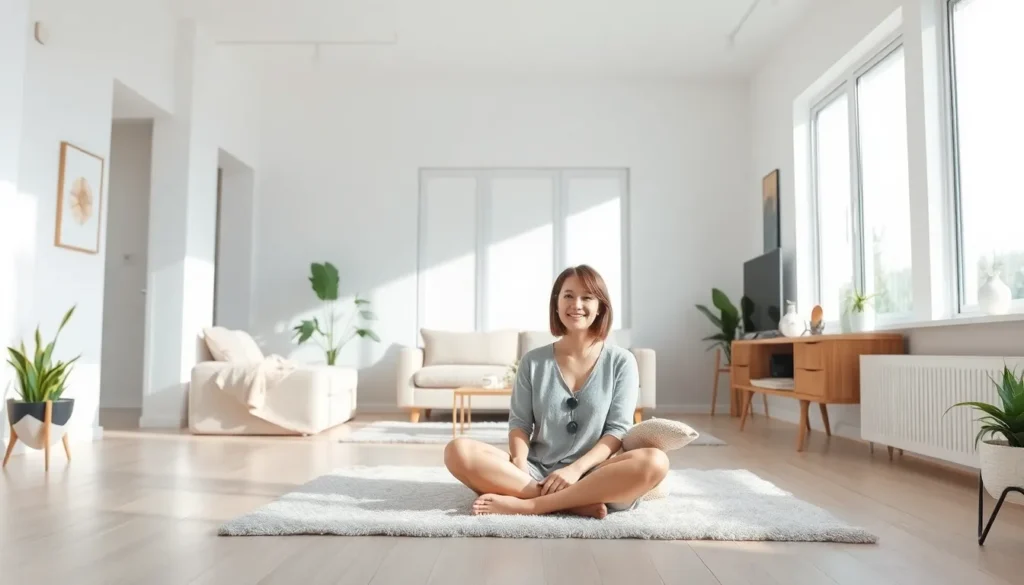Table of Contents
ToggleIn a world overflowing with stuff, the idea of minimalist living might seem as radical as wearing socks with sandals. But fear not—embracing minimalism doesn’t mean sacrificing joy or comfort; it’s about finding freedom in simplicity. Imagine a life where clutter doesn’t rule your space or your mind. Instead of searching for your keys under a mountain of junk, you’ll bask in the bliss of a tidy home.
Understanding Minimalist Living
Minimalist living embodies a lifestyle choice centered on simplicity and intentionality. This approach encourages individuals to evaluate their possessions and commitments, focusing on what truly enriches their lives.
What Is Minimalism?
Minimalism is a lifestyle that strips away excess, promoting the idea of living with only what is necessary. It encompasses more than just decluttering physical spaces; minimalism also applies to emotional and mental well-being. Emphasizing quality over quantity, minimalism invites people to cherish meaningful experiences instead of accumulating material goods. Practitioners often report a newfound appreciation for the essentials in life, such as relationships, nature, and personal growth.
Benefits of Minimalist Living
Minimalist living offers numerous advantages that enhance overall well-being. First, reduced clutter leads to improved mental clarity and focus. Organized spaces minimize distractions, empowering individuals to concentrate on tasks and goals. Second, financial savings become apparent as individuals spend less on unnecessary items. Saving money contributes to greater financial freedom. Third, minimalist living fosters emotional resilience by encouraging gratitude and contentment with fewer possessions. This shift in mindset often yields increased life satisfaction and reduced stress.
Minimalist Living Examples in Home Design

Minimalist home design embodies simplicity and functionality. It’s all about curating spaces that inspire tranquility and practicality.
Open Spaces and Decluttered Rooms
Open spaces enhance a sense of freedom. They allow light to flow naturally through rooms, creating an airy atmosphere. Decluttered rooms emphasize essential furnishings. Clutter-free surfaces invite calm and promote mindfulness. Using fewer, well-chosen decor items creates focal points within the space. Each piece serves a purpose, reinforcing the minimalist ethos. Neutral color palettes support this aesthetic by harmonizing the environment. They cultivate relaxation and focus, making open spaces more appealing.
Multi-Functional Furniture
Multi-functional furniture maximizes space usage. Transforming a standard table into a work desk or a storage unit is practical and efficient. Various designs blend style and utility, catering to diverse needs. A sofa bed serves both seating and sleeping requirements, ideal for smaller areas. Modular shelving units can adjust according to storage demands, showcasing versatility. Selecting pieces with hidden storage features enhances organization without sacrificing aesthetics. These combinations allow homeowners to embrace minimalism while enjoying comfort and convenience.
Minimalist Living Examples in Lifestyle
Minimalist living manifests in various lifestyle choices that prioritize simplicity and intentionality. These examples illustrate how individuals successfully embrace minimalism.
Simplifying Daily Routines
Streamlining daily routines enhances efficiency. He prepares simple breakfasts, like oatmeal or smoothies, to save time. She chooses versatile recipes that require fewer ingredients, minimizing meal prep stress. Utilizing online calendars enables them to eliminate unnecessary commitments. Keeping tasks focused on essentials promotes a sense of accomplishment. Adopting a consistent cleaning schedule helps maintain a tidy home, reducing clutter accumulation. Embracing these practical strategies leads to smoother days and less mental chaos.
Capsule Wardrobe Concept
A capsule wardrobe simplifies clothing selection. It consists of a limited number of versatile pieces that mix and match easily. She often includes basic items, such as solid-color tops and neutral bottoms, maximizing outfit variations. Accessories provide additional styling options without cluttering the space. Choosing quality over quantity ensures durability and reduces replacement frequency. This concept streamlines mornings, making it easier for individuals to style themselves quickly. Ultimately, the capsule wardrobe fosters a more intentional approach to personal style and reduces decision fatigue.
Minimalist Living Examples in Digital Spaces
Digital minimalism focuses on simplifying online experiences to reduce distraction and enhance productivity. Individuals embrace intentional use of technology, achieving a more streamlined digital life.
Decluttering Digital Devices
Decluttering digital devices involves removing unnecessary apps, files, and emails, aiming to create a more organized and efficient workspace. Organizing folders based on priority can improve navigation and access to important documents. Regularly deleting old emails and files prevents accumulation of clutter. Utilizing tools like cloud storage enhances accessibility and safety, reducing reliance on physical devices. Prioritizing essential applications fosters a focused environment, enabling smoother task completion. Streamlining notifications helps limit distractions, allowing users to concentrate on what truly matters.
Minimalist Aesthetic in Design
Minimalist design in digital spaces emphasizes clean lines and a user-friendly interface. Utilizing a limited color palette creates visual harmony, drawing attention to key elements. Prioritizing functional layouts enhances usability, making navigation intuitive and straightforward. Incorporating ample white space allows content to breathe, reducing cognitive overload and improving user engagement. Choosing simple typography contributes to readability, ensuring users grasp information quickly. Removing unnecessary graphics or animations helps maintain focus, aligning with the principles of minimalism and enhancing overall user experience.
Embracing minimalist living can transform one’s life in profound ways. By prioritizing simplicity and intentionality individuals can cultivate a serene environment that enhances mental clarity and emotional well-being. The practical examples and design principles discussed illustrate how minimalism extends beyond physical spaces into daily routines and digital experiences.
Adopting this lifestyle not only reduces stress but also fosters a deeper appreciation for what truly matters. As one simplifies their surroundings and commitments they unlock the freedom to live more fully and authentically. Minimalism offers a path to a more meaningful existence where joy is found in less rather than more.




